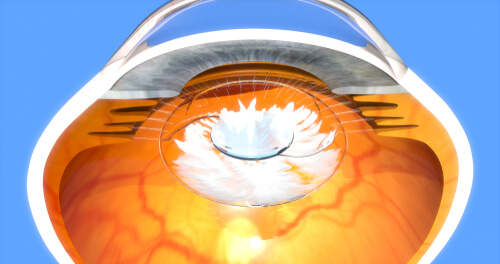YAG Laser Capsulotomy – Laser Treatment after Cataract Surgery

Your eye following cataract surgery:
When your cataract was removed, the natural lens of your eye was replaced with an intraocular lens implant or IOL. This clear lens implant is placed inside the clear natural lens capsule. Your vision is restored because the implant allows focused light to reach your retina, which sends visual messages to the brain. The YAG laser capsulotomy surgery is a laser surgery that approximately 80% of patients need months or years after cataract surgery if the posterior capsule gets cloudy with time. The YAG laser is available in our surgery center so capsulotomies can be performed when necessary.
Why YAG laser capsulotomy may be necessary.
A YAG laser capsulotomy may be necessary in approximately 80% of patients who have undergone cataract surgery. Vision can again become cloudy due to clouding of the posterior capsule, a natural part of the eye holding the lens implant in place. Fortunately, your eye surgeon can usually restore your vision quickly by performing a laser treatment called YAG laser capsulotomy.
When the capsule becomes cloudy.
The natural lens capsule is a thin, clear cellophane-like sac around the cataract. During implant surgery, the front of the capsule is removed and the cataract is emulsified and suctioned out of the eye. The lens implant is placed inside the lens capsule behind the pupil. Months or even years after the cataract surgery, the posterior layer of the lens capsule behind the lens implant may become cloudy; this clouding blocks light from reaching the retina, just as the cataract did. This clouding occurs eventually in about 80% of patients. Modern medical science has not developed a way to prevent this clouding of the lens capsule.
How YAG laser works:
A laser is a powerful beam of light that can be focused to a tiny point. Because laser light can be precisely controlled, it is very effective and reliable. For a capsulotomy, your eye surgeon uses the YAG laser to deliver tiny, rapid bursts of energy to create a clear opening in the cloudy posterior lens capsule about the size of your pupil. This allows light to be focused clearly in the eye again, reaching the retina. The laser passes through the clear tissue at the front of the eye and through the implant without harming them. Enough of the posterior capsule is left behind to hold the implant securely in place.
Before YAG laser capsulotomy
Arrange to have a driver bring you to and from the Eye Surgery and Laser Center, LLC. Your vision may be blurry for a short time following the treatment until the dilating drops have worn off. You may undergo a visual exam, and both eyes may be dilated. Drops may be instilled to regulate the pressure in the eye. Your vital signs will also be checked.
Your YAG laser experience:
The treatment is painless, and you can usually return to your normal activities within a few hours. There are no needles or stitches and no risk of infection. You will probably find your vision fully restored shortly following the treatment after the dilating drops have worn off.
Possible Risks:
You should be aware there are possible risks associated with any surgery, including the YAG laser. Eye pressure may rise briefly following the laser treatment. Drops are put in your eye before the laser surgery to minimize this risk. The long-term risk of glaucoma is not significantly increased after YAG laser capsulotomy.
The risk of retinal detachment is increased after YAG laser capsulotomy, although it is still a low risk (generally 1 – 2% unless there are other risk factors). To minimize this risk, all patients are asked to report immediately for a retinal exam any time new floaters are noted in their vision. In rare (less than 1%) instances, after YAG laser capsulotomy patients may get transient retinal/macular edema, inflammation in the eye that can require eyedrop treatment, or the lens implant may slip out of place requiring surgical re-positioning. YAG laser capsulotomy usually quickly restores your vision to as good as it was shortly after the lens implant surgery. There is less than 1 in 500 chance that the clouding will recur.
Selective Laser Trabeculoplasty (SLT)
Selective laser trabeculoplasty (SLT), is a laser method for lowering eye pressure in patients with open-angle glaucoma by targeting the drainage tube of the eye. It is an outpatient procedure and is typically painless. Selective laser trabeculoplasty works on the drain to increase the amount of fluid that flows out. This does not produce a scar or burn the drain, thus allowing this type of laser to be repeated several times, if necessary. It typically works in 75% to 80% of patients to lower the eye pressure.
Should you have pain or decreased vision in your postoperative period, you should immediately call the office and be seen. There are typically no limitations on activity after the laser procedure. However, the patient should not drive home after the laser procedure and not drive until the vision is clear.
Postoperatively, patients are asked to continue their regular glaucoma medications. It takes approximately six to eight weeks to know if the laser has done an effective job in lowering your pressure. At that time, consideration of either changing or starting/stopping eye-drops will be made.
Laser surgery is not a cure for open-angle glaucoma. However, it can work similarly to adding a strong medication to the medications that the patient is using, or it can work to replace eye drops in some cases, thus continued follow-up with your eye doctor is necessary.
As with any procedure, there are risks, which include inflammation in your eye, decrease or loss of vision which can be permanent, or pressure elevation requiring additional procedures or surgeries to achieve pressure control.
Laser Peripheral Iridotomy (LPI)
This is the laser procedure used to treat narrow-angle glaucoma. It is an outpatient procedure and is typically painless. Laser peripheral iridotomy (LPI) creates a small hole in the iris (colored part of the eye) to provide a direct pathway for fluid to reach the drainage tube of the eye. The opening is typically hidden under the eyelid and should not be visible, as it is very small. Some irises, especially those that are dark brown, may require more than one treatment to secure a permanent opening; however, this is extremely rare. This laser typically is successful 95% of the time and rarely needs to be repeated.
It is important to note that this laser does not cure glaucoma but reduces the risk of developing acute angle closure glaucoma which can be a sight-threatening emergency leading to permanent vision loss.
As with any procedure, there are risks, which include inflammation in your eye, decrease or loss of vision which can be permanent, or pressure elevation requiring additional procedures or surgeries to achieve pressure control. In addition, light can get through the small hole causing glare or a ghost image.
Laser Iridoplasty
Laser iridoplasty is another technique to treat narrow angle glaucoma, and is an outpatient procedure. Laser iridoplasty creates small burns in the peripheral iris for 360 degrees inside the eye. The heat applied to the peripheral iris causes it to shrink, which pulls the peripheral iris away from the drainage tube of the eye. It is usually considered after the laser iridotomy procedure is completed if the desired effect is not achieved. There is some mild sensation to this laser; however, it is typically not painful.
As with any procedure there are risks, which include inflammation in your eye, decrease or loss of vision which can be permanent, or pressure elevation requiring additional procedures or surgeries to achieve pressure control. In addition, the pupil may not be round or dilate as well after the procedure.
What to Expect During a Laser Procedure.
These laser procedures are considered outpatient procedures and usually only one eye is treated with the laser at a time. On the day of your laser procedure, you will come to the surgery center, have all of the appropriate paperwork completed, and have eye drops placed in your eye. The drops help control the eye pressure and prepare the eye for the laser. These drops may cause a mild to moderate headache.
After the eye is anesthetized with eye-drops, a contact lens is placed on the eye during the laser procedure and will be removed immediately afterward. The vision may be slightly blurry, due to the drops and gel placed in the eye. This should resolve in the first several hours after the laser. After the laser is completed, your pressure will be checked to ensure that you are not experiencing a “pressure spike.” Based on the type of laser completed, you may be discharged with an anti-inflammatory eyedrop to be used until you are seen at your follow-up postoperative visit. Typically, patients are seen in one to two weeks after a laser procedure; however, should you notice any changes in your vision or an increase in pain or redness, you should call the office immediately to be seen.



